Exploring the Finch Bird: Characteristics and Care
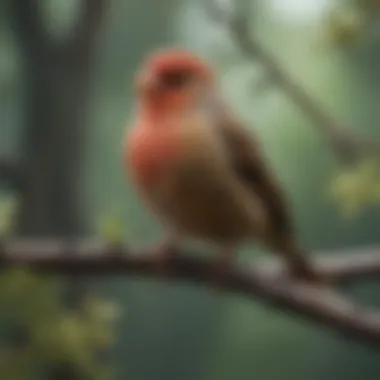
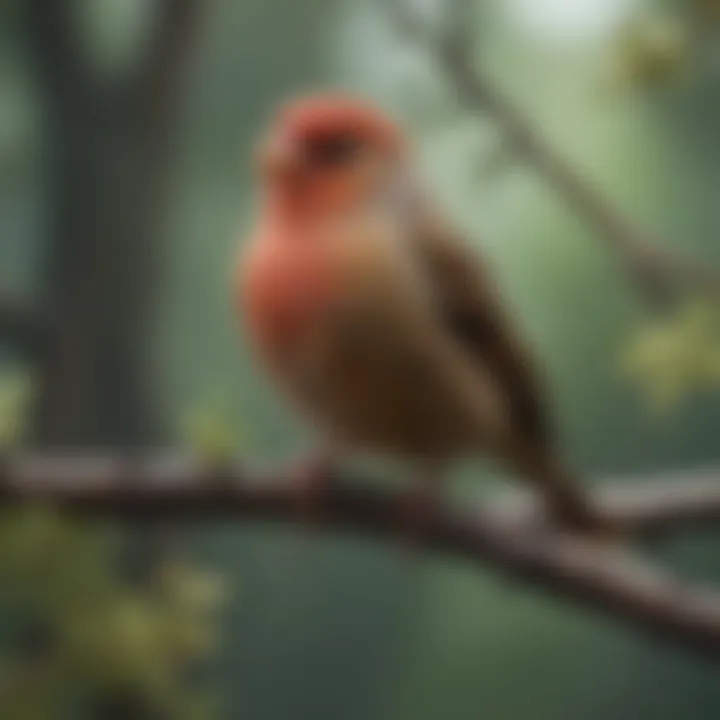
Intro
Finches, those petite and colorful birds, often capture the hearts of many bird enthusiasts. They flutter about, chirping melodically and exhibiting a range of shades that can brighten anyone's day. This class of birds encompasses over a hundred species that vary greatly in color, size, and behavior. Within these pages, we aim to provide a deeper understanding of finches as pets, exploring everything from their basic behavioral instincts to their intricate needs and the joy they can bring into a household.
Learning about finches goes beyond mere aesthetic appeal. These birds can offer companionship, education for children, and a point of connection with nature. Understanding these birds can help create a fulfilling relationship between a finch and its cared-for owner. By delving deeper into their worlds, not only do we enrich our own lives, but we also contribute to their well-being. Let’s dive into understanding your pet finch more thoroughly.
Understanding Your Pet
Pet Behavior Basics
When it comes to finches, being aware of their natural behaviors is essential for fostering a stable environment. For instance, finches are social creatures, thriving in the company of their own kind. They can exhibit behaviors like preening each other and chirping in a conversational manner, which reflects their need for social interaction. It’s important to keep them in pairs or small groups, as isolation can lead to stress and behavioral issues.
Common Breed Characteristics
Different species of finches come with distinct characteristics. Here are a few notable traits:
- Zebra Finch: Known for its easily recognizable stripes and cheerful nature. They are often recommended for beginners.
- Society Finch: A more social breed that is generally friendly and amiable, making them great companions.
- Bengalese Finch: Known for their melodious songs; they have an inviting charm and an affectionate demeanor.
Species-Specific Needs
Each finch species has specific requirements for care that prospective owners should consider. For example, larger species like the Java Sparrow might need more space than smaller ones like the Gouldian Finch. Understanding these nuances ensures that every finch owner can meet their pet's unique needs appropriately.
Pet Care and Maintenance
Feeding Guidelines
Just like any pet, finches require a balanced diet. A typical finch diet might include:
- Seed Mix: A specially formulated mix appropriate for finches.
- Fruits and Vegetables: Fresh offerings like leafy greens, carrots, and apples should form part of their treats, ensuring they get essential vitamins.
- Egg Food: Particularly crucial during breeding seasons, this food helps promote healthy growth.
Grooming Essentials
While finches groom themselves quite well, helping them with minor grooming can be beneficial. You might notice that their beaks can get a bit stained, especially after enjoying various foods. A gentle wipe with a damp cloth can keep your little friend sparkling.
Hygiene Practices
Maintaining cleanliness in their living environment is key. Clean the cage regularly, remove any uneaten food, and replace the water daily. Keeping their space tidy minimizes the risk of illness and makes for a happier finch.
Training and Development
Basic Commands and Skills
Training finches, though not as straightforward as training dogs, is still very possible. Using consistent phrases and positive reinforcement can help your finches recognize commands over time. Simple whistles or clicks can also signal to them when it's time for a treat.
Behavioral Training Techniques
Watch for unwanted behaviors; signs of boredom may manifest in feather plucking or excessive vocalization. To combat this, provide engaging toys or rotate them periodically. Change can help keep their curious minds active.
Addressing Common Behavior Issues
If your finch seems withdrawn, check its environment. Stress can stem from things like loud noises or other pets. Ensuring a stable and quiet environment helps significantly.
Health and Wellness
Routine Vet Check-ups
Just like any other pet, regular vet visits areas vital for finches. A yearly check-up helps keep your bird healthy and ensures any potential issues are caught early.
Vaccination Needs
While finches are generally resilient, some situations may call for vaccines, especially if they’ve been exposed to other birds. Consulting with an avian vet can clarify the necessary vaccinations.
Recognizing Signs of Illness
Being vigilant about health means keeping an eye out for any abnormal behavior. If you see lack of appetite, puffed-up feathers, or lethargy, these can be signs your finch needs attention. Detecting issues early is crucial for effective treatment.
Enrichment and Activities
Indoor vs. Outdoor Activities
Providing enrichment is crucial for a finch’s physical and mental health. Indoor activities might include offering swing toys or creating obstacle courses. If you feel confident and the weather permits, some supervised outdoor time in a secure aviary can offer exciting stimulation.
Interactive Toys and Games
Toys that challenge their intelligence should be part of the mix. Puzzle toys, for instance, encourage them to work for their food. Finches are curious, and providing such toys can help satisfy that instinct and stave off boredom.
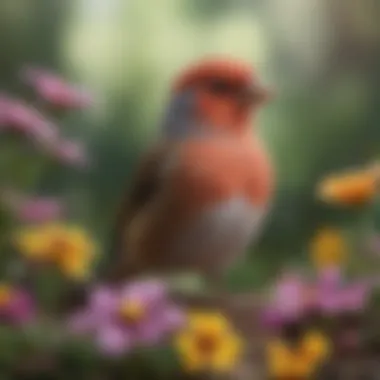

Socialization Opportunities
Exposure to other finches can be beneficial but must be done carefully. If introducing a new finch, do so gradually to avoid territorial conflicts. Overall, maintaining a harmonious environment enhances their way of life.
By understanding and meeting the needs of your pet finch, you not only ensure its happiness but also create a fulfilling companionship.
In the end, finches might be small, but they are full of life and quirks that can make them delightful additions to any pet-loving family. With knowledge in hand, you can promote a vibrant and healthy existence for these charming birds.
Prolusion to Finches
Understanding the world of finches is a journey into the intricacies of one of nature's most diverse bird families. Finches are not just charming creatures; they embody a wealth of biological traits, connections with their environments, and cultural significance. This exploration serves multiple purposes: for animal lovers who admire finches’ beauty, for families teaching children about wildlife, and especially for pet owners eager to grasp the essentials of care and breeding.
The finch family, encompassing numerous species, showcases a vast range of colors and behaviors. Exploring their characteristics opens up avenues for appreciating biodiversity. These small birds are often a first step into the avian world for many people, serving as gentle introductions to broader ecological and conservation topics.
In this section, we'll break down the fundamental aspects defining finches and delve into their history, giving readers insights into how these delightful birds have evolved over time. By understanding their past and defining traits, we will lay the groundwork for the discussions that follow about their biological characteristics, habitat, and more.
Defining the Finch Family
The finch family, scientifically known as Fringillidae, comprises small to medium-size birds, often with a robust beak adapted for eating seeds. This family includes many well-known species, like the house finch and the colorful goldfinch. Finches can be spotted in various habitats, from gardens to forests, showcasing their adaptability.
Major characteristics of finches include:
- Beak shape and size: Typically conical, ideal for cracking seeds.
- Size: Generally small, with varying lengths from about 4 to 8 inches.
- Coloration: A wide spectrum exists—some are brightly colored while others are more subdued, aiding in their camouflage.
Finches are social creatures, often seen in flocks, and their lively chattering adds a delightful soundtrack to nature walks. Notably, they have keen sight, enabling them to spot food from a distance. Understanding these basics is crucial for enthusiasts and pet owners alike, who can appreciate their behavior better.
Historical Overview of Finches
The tale of finches stretches back millions of years, tracing their origins and evolution across continents. Finches have adapted remarkably, filling various ecological niches. For example, the famed Darwin’s finches from the Galápagos Islands provide critical insights into natural selection. Observed by Charles Darwin, these birds diversified into multiple species with distinct beak shapes, suited to different food sources, underscoring the principle of adaptation.
Throughout history, finches have been connected to human life, from being kept as pets in ancient Rome to being subjects of scientific study today. Their prevalence in art and literature reflects a historical fascination that remains intact. The evolution of finches not only highlights their resilience but also serves as a reminder of the ongoing need for conservation efforts as many species face threats from habitat loss and climate change.
In summary, the exploration of finches is more than just an examination of a bird family; it is an invitation to appreciate the complexities of nature and our relationship with it. As we delve deeper into their biological characteristics and cultural significance, a more profound understanding of finches as integral members of our ecosystem emerges.
Biological Characteristics of Finches
Understanding the biological characteristics of finches is central to appreciating these birds. Their unique traits not only define them but also play a crucial role in their adaptation to various environments and their interactions with both ecosystems and humans. This section delves into their physical traits, dietary needs, and growth patterns, providing insights that can benefit pet owners and nature enthusiasts alike.
Physical Traits and Variations
Finches exhibit a striking variety of physical traits, making them a visually captivating group of birds. These traits can vary even within the same species, giving each individual a unique charm. The most distinguishing features include their size, plumage, and beak shape.
- Size: Most finches are small, typically ranging from about 4 to 10 inches in length. The tiniest, like the Goldfinch, can be as small as 4.5 inches, while larger species, such as the House Finch, can grow to nearly 8 inches.
- Plumage: The colors can be vibrant or muted, depending on the species and their habitats. Some, like the American Goldfinch, sport bright yellow feathers in spring, while others, like the European Greenfinch, have a more subdued olive-green appearance.
- Beak shape: Their beaks are often conical, ideal for cracking seeds and nuts. Different species have developed beaks adapted to their specific diets, showcasing nature's versatility. For example, the Crossbill has a uniquely shaped beak designed to extract seeds from conifer cones.
These variations not only serve practical purposes but also play a role in courtship behaviors and social signaling among finches.
Dietary Needs and Preferences
Finches are often seed aficionados, with diets predominantly composed of seeds from grasses, weeds, and trees. However, their dietary habits can vary significantly based on habitat and season.
- Seeds: Firm favorites include sunflowers, dandelions, and thistle seeds. Pet owners should consider providing a blend of these seeds to keep their pets healthy and satisfied.
- Fruits and Vegetables: Many finches also enjoy fruits, particularly berries and soft, ripe produce. Leafy greens can be a hit as well, offering vital nutrients.
- Insects: Young finches, especially those in their juvenile stage, sometimes require protein from soft insects to support their growth. This aspect of their diet is crucial for breeding pairs as they rear their young.
According to various experts, providing a varied diet helps maintain the finch's vitality and enhances their natural behaviors. Providing a balanced mixture will not only promote healthy growth but also mirror their dietary preferences in the wild.
Lifespan and Growth Patterns
Lifespan among finches can show a remarkable range, influenced by factors including species, environment, and diet. Generally, pet finches can live longer than their wild counterparts due, in part, to the absence of predators and consistent food supply.
- Average lifespan: On average, finches can live between 5 to 10 years, depending on species. Some Zebra Finches, for instance, may anchor themselves closer to the 5-year mark, while others, like Society Finches, might reach up to 10 years.
- Growth pattern: The growth stages of finches are as intriguing as their traits. After hatching, they enter a fragile state, relying entirely on their parents. Within weeks, they start to develop feathers, and by the time they are about three weeks old, they can venture outside the nest gradually.
The transition from nestling to adult is a critical phase. Understanding these growth patterns can help pet owners provide the right support during rearing or see to the requirements of finches as they age.
"The life cycle of finches showcases nature's resilience and beauty, making them not only fascinating to observe but also to nurture."
In summary, these biological characteristics underscore the relevance of finches in nature's grand design and provide essential insights for those who cherish these birds, whether in the wild or at home.
Habitat and Distribution
Understanding the habitats and distributions of finches is crucial, as it underscores their ecological niches and the environmental factors that sustain their populations. Every finch species is unique in its habitat preferences, often reflecting a delicate balance between their biological needs and the external conditions they encounter. This section aims to elucidate the importance of habitat in the survival and proliferation of finches, while also providing insight into how varying ecosystems influence their behavior and lifestyle.
Global Distribution of Finch Species
The finch family can be found gracing many corners of the globe, from the misty highlands of the Andes to the beaches of the Caribbean. Their adaptability is noteworthy, a factor that plays a significant part in their wide distribution. For instance, species like the Zebra Finch thrive in arid regions of Australia, while the Goldfinch prefers the temperate climates of Europe and North America.
- North America: Here resides the American Goldfinch, a bright yellow bird often spotted flitting around backyard feeders. Its migratory patterns, moving south in the winter, showcase how habitat necessity drives movement.
- South America: The Galapagos Islands are home to several unique finch species, famously studied by Charles Darwin. That’s where finches showed the notion of adaptive radiation, evolving distinct traits based on their specific environments.
- Africa and Asia: The species like the Greenfinch can be seen across Europe and into Western Asia, demonstrating how broadly these birds adapt to various ecosystems.
This global spread emphasizes their ability to thrive in diverse environmental conditions, highlighting different adaptations that allow various finches to occupy their respective ecosystems successfully.
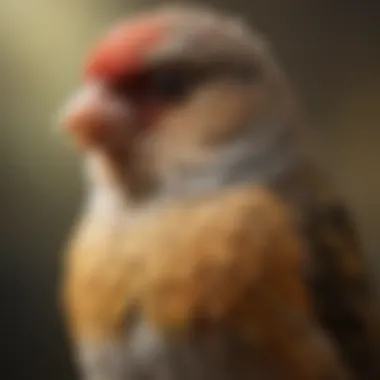
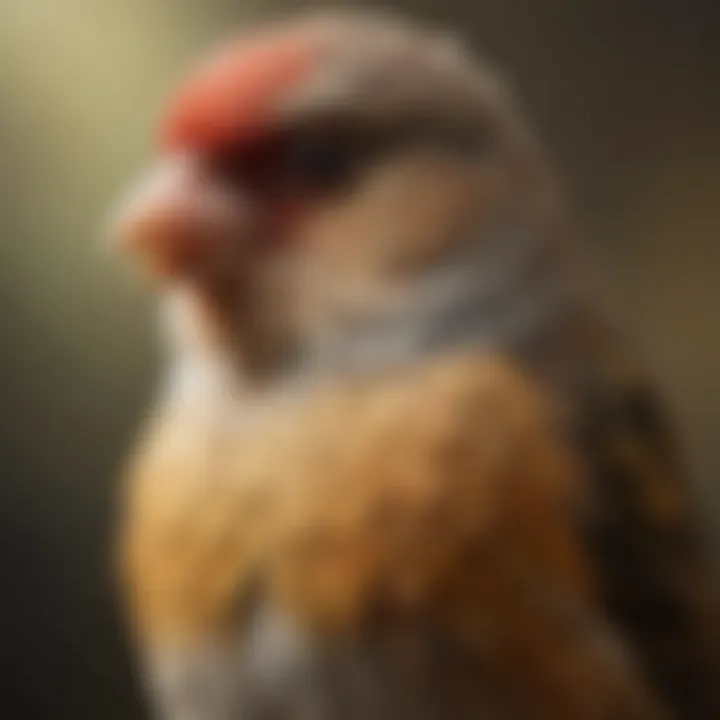
Typical Habitats and Nesting Behavior
Finches show a variety of nesting behaviors that adapt well to their respective environments. Each species customizes its nesting approach based on habitat availability and environmental threats.
Common habitats include:
- Grasslands: Many finches, such as the House Finch, are often found in urban areas and grasslands, where they exploit open spaces to nest in trees and shrubs. They nest in nesting boxes or even manmade structures, showcasing their ability to adapt.
- Woodlands: Species like the Purple Finch prefer denser habitats with ample trees. Their nesting sites are often located away from disturbance, hidden in tree foliage, allowing them to raise their young with a certain degree of safety.
- Wetlands: Even in wetlands, finches can be spotted, utilizing reed beds and nearby shrubbery for cover and nesting materials.
Nesting behavior varies, with some constructing elaborate nests using grasses, feathers, and other accessible materials, while others take a more minimalist approach. Their nesting season typically coincides with optimal resource availability, allowing for successful breeding.
"Finch nesting behaviors not only reflect their adaptability but also underline the species' intricate relationship with their ecosystems."
In summary, the habitats and distribution of finches underline their remarkable adaptability and ecological importance. By examining where these birds live and the conditions they require, we gain insightful perspectives into ongoing conversations about conservation and habitat preservation. Each species and its environment tell a story about survival and the delicate threads that connect all life forms.
Behavioral Patterns of Finches
Understanding the behavioral patterns of finches is crucial for anyone wanting to delve into their lives. These birds are not merely pretty creatures flitting about with ease; their behaviors reveal a tapestry woven with social dynamics, communication forms, and survival strategies. Observing how finches interact can deepen one's appreciation of them, highlighting their adaptability and intelligence. Furthermore, these behavioral traits are often key to their success as a species.
Social Structures and Group Behavior
Finches are inherently social birds. They thrive in flocks, which provide safety and facilitate foraging. This group living isn't just about sticking together for protection. Finches engage in intricate social structures that can vary from species to species. Some finch species exhibit a hierarchy on a daily basis, with dominant birds taking the lead in foraging spots and nesting sites. Others may form egalitarian groups where every member enjoys equal access.
In these social gatherings, you may notice playful interactions, where young finches engage in behaviors resembling play. This is more than just frolicking; through these activities, they learn essential survival skills.
"The joy of observing finch behavior lies in the details—each chirp and flutter holds a meaning of its own."
Moreover, the flocking behavior allows finches to communicate danger quickly. A sudden alarm call can send the group into a flutter of wings, each member responding almost instinctively. This communal alertness is vital. It means that while a single finch might risk becoming a meal for a predator, together, they have a better chance of evading danger.
Communication Methods
Communication among finches is a fascinating study in itself. They employ a variety of vocalizations to convey messages, from cheerful chirps that signify contentment to sharp calls that indicate danger. Each species has its own set of calls, and these can vary based on the season, social status, and the specific context of the situation.
Beyond vocal sounds, finches also communicate through body language. For example, a finch might lower its head or fluff up its feathers if it feels threatened. Such movements can convey aggressive intentions or submissive stances, clarifying their social position within the group.
In nesting periods, male finches often display elaborate courtship songs to attract females. These performances are not just melodic; they are intricate displays involving physical movements, showcasing the male's fitness.
In summary, the behavioral patterns of finches not only provide insight into their survival strategies and social structures but also create a richer understanding of their ecological role and significance. Recognizing these behaviors helps foster a greater respect and admiration for these remarkable birds.
Cultural Significance of Finches
When one considers the cultural significance of finches, it’s clear that these small birds have woven themselves into the fabric of human experience over time. Their presence in folklore, literature, and even in everyday conversation reflects a deep-rooted appreciation that goes beyond mere aesthetics. This section will explore how finches have been depicted in art and literature, and their symbolic meanings across various cultures.
Finches in Literature and Art
Finches have made a notable appearance in literature and art throughout the ages, serving as a muse for many writers and artists. These birds often symbolize freedom and joy, thanks largely to their lively nature and melodious songs. In poetry, finches might be referenced to evoke themes of love and beauty. For instance, a poet might write about a finch’s song as an allegory for unrequited love—its sweet notes echoing the complexities of human emotions.
Moreover, artists from various epochs have used finches in their paintings, portraying the delicate features and vibrant colors that make these birds so captivating. An example is John James Audubon, whose illustrations of American finches brought the subject to life, highlighting not only their beauty but also their importance in the ecosystem.
In modern literature, finches continue to inspire. Works like "To Kill a Mockingbird" by Harper Lee illustrate how the innocence of youth is akin to the fleeting, untainted beauty of these birds. They serve as a reminder of nature’s fragility amidst the chaos of the human condition.
Symbolism and Folklore
Across many cultures, finches carry significant symbolic weight. For example, in some Native American traditions, the finch is viewed as a harbinger of good luck and future prosperity. Similarly, in Celtic folklore, these birds are often associated with joy and celebration. To receive a visit from a finch can signify impending happiness and prosperity; thus, birds like the goldfinch frequently feature in blessings and charms.
In European culture, finches have been linked to the themes of communication and companionship. The song of a finch is often interpreted as one’s voice—its melody representing the spirit of conversation and connection between individuals. In urban settings, when people hear a finch sing amid the bustling sounds of life, it can inspire a moment of reflection and appreciation for the simple joys.
Here are some ways finches are symbolically understood:
- Joy and happiness: Often associated with the cheerful songs they sing.
- Freedom: Their ability to flit from branch to branch symbolizes liberation and the beauty of unrestrained movement.
- Good fortune: Many cultures believe that seeing a finch can bring about luck and prosperity.
"In every creature, the universe finds a whisper of its stories untold, and finches, with their songs, hold a mirror to our very souls."
In summary, finches are more than just birds flitting about in gardens; they embody timelessness, resilience, and a myriad of human emotions. Understanding their role in culture and art offers deeper insights into how intertwined our lives are with nature and its endless narratives.
Finches remind us to appreciate the delicate balance of our ecosystems and the tales that have been spun through the ages.
Finches as Pets
Keeping finches as pets has become quite the trend among bird lovers and families alike. Their chirpy songs and vibrant colors add cheer to any home. Finches are generally social, making them suitable for families or individuals seeking companionship. Moreover, they come with a relatively low maintenance requirement compared to other birds, which makes them an appealing choice. While they do demand attention and a proper environment, they offer a rewarding pet experience.
Popular Finch Species for Pet Owners
When it comes to choosing a finch, certain species stand out for their domestic qualities:
- Zebra Finch: Renowned for their friendly demeanor, these little guys are easy to care for and breed, making them a favorite among beginners.
- Society Finch: Known for their calm personality, they thrive in groups and adapt well to various living conditions.
- Gouldian Finch: With their stunning colors, these finches are visually captivating. They require a bit more care but are well worth it for their beauty.
- Canary: Though technically not a finch, they are often grouped with them. Their song and colorful feathers can bring vibrant life to any room.
Choosing the right species is crucial for ensuring a great pet experience. Each type comes with its distinct needs and behaviors, so understanding them will help adopting the right finch for your lifestyle.
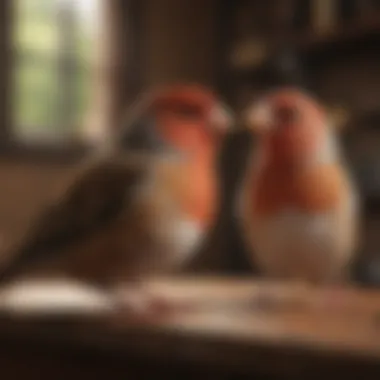
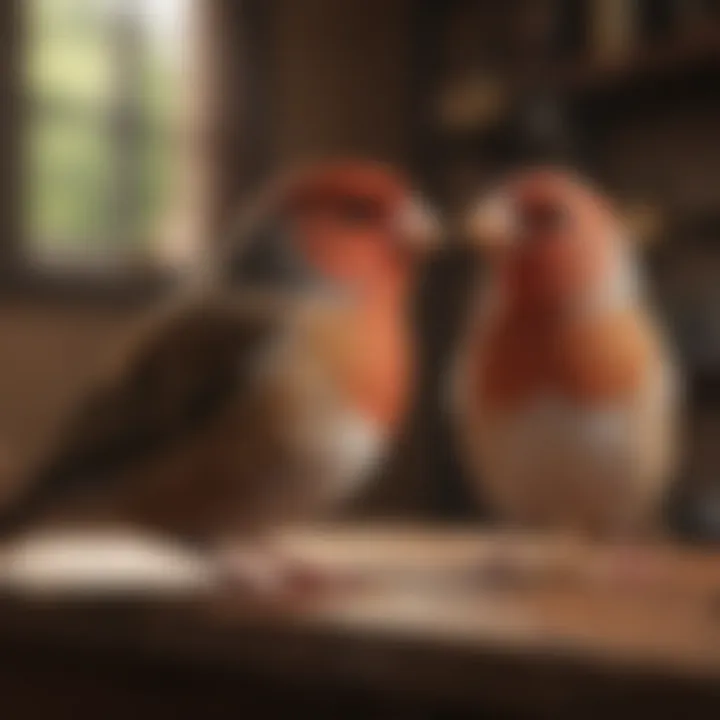
Care and Maintenance of Pet Finches
Caring for finches involves creating a suitable environment. Here are some key aspects to consider:
- Housing: A spacious cage is vital. An ideal cage should be at least 30 inches long, with horizontal bars for climbing, and it needs to be well-ventilated.
- Diet: Finches thrive on a balanced diet consisting of finch seed mixes, fresh fruits, and vegetables. It's important to rotate their menu to keep their meals exciting.
- Social Interaction: Finches are very social creatures and generally prefer to live in pairs or small groups. Therefore, keeping more than one can help them stay happy.
- Hygiene: Regular cleaning is non-negotiable. The cage should be disinfected weekly to avoid bacterial growth and health issues.
Taking care of these little birds is not as daunting as it sounds. Proper housing, diet, and social interaction create a happy and thriving environment for your finches.
Breeding Finches in Captivity
Breeding finches can be fascinating but does require some homework. Here are key pointers:
- Determine Compatibility: Ensure you have a male and female finch, and they should ideally be of the same species to breed successfully.
- Breeding Conditions: Provide a suitable nesting box and ensure their cage offers ample space for the female to feel safe while laying eggs.
- Diet Prior to Breeding: Boost their diet with extra protein in the weeks leading to breeding. This can include egg food, which greatly aids in the health of the breeding pair.
- Nurturing the Young: Once the eggs hatch, monitor the young finches. They will need parental guidance for the first few weeks. Providing a nutritious diet during this period is imperative.
Breeding can be a rewarding experience for any finch owner, but understanding the needs and behaviors of the birds is fundamental to protecting their well-being during this time.
"Understanding your finch's needs is the first step towards a fulfilling relationship with these beautiful creatures."
In summary, keeping finches as pets can bring joy and satisfaction. They require some commitment, but with proper knowledge, they will thrive and provide companionship and beauty to your home.
Conservation Status of Finch Species
The conservation status of finch species is a critical topic in understanding not only the well-being of these charming birds but also the overall health of our ecosystems. Finches play significant roles in their environments through their food foraging habits and seed dispersal, which can have cascading effects on the vegetation and animal life. With various threats looming, it’s ever more pertinent to shed light on the factors influencing their populations.
Threats to Finch Populations
Finches are faced with a range of threats, many of which are exacerbated by human activity. Here are some primary concerns affecting their numbers:
- Habitat Destruction: Urbanization and agricultural expansion often lead to the destruction of natural habitats where these birds thrive. Deforestation, in particular, eliminates the resources finches need to survive and breed.
- Climate Change: As temperatures rise and weather patterns shift, finches must adapt to their changing environments. These alterations can affect their food sources, breeding seasons, and migration paths.
- Pollution: Pesticides and other pollutants can poison finches indirectly through the food web. Insects and plants that are contaminated can affect the health of finches, impacting their ability to reproduce and survive.
- Invasive Species: The introduction of non-native plants and animals can disrupt existing ecosystems. For example, if invasive species outcompete native plants that provide food for finches, these birds may struggle to find sustenance.
Awareness of these threats is crucial for understanding why conservation initiatives are required to protect these birds.
Conservation Efforts and Initiatives
Across the globe, various organizations and initiatives have taken steps to conserve finch populations. Here are some noteworthy efforts:
- Habitat Restoration: Many conservation groups work on rehabilitating damaged ecosystems to ensure suitable habitats for finches. This involves planting native vegetation and suppressing invasive species to create a welcoming environment for native birds.
- Education and Outreach: Raising awareness among communities about the importance of finches can lead to more local conservation efforts. This includes workshops and programs encouraging people to create bird-friendly spaces in their backyards.
- Research Initiatives: Conducting scientific studies on finch populations helps in understanding their behavior, reproduction, and adaptation to changing conditions. Research can guide conservation strategies by providing essential data.%0A
- Legislation and Protection: Governments and international bodies are working to implement laws that protect endangered finch species and their habitats. Legislative frameworks play a vital role in advocating for wildlife preservation.
"The survival of finches and their ecological roles highlight the interconnectedness of nature, making conservation efforts vital not just for the birds, but for the health of our planet as a whole."
By taking a combined approach that includes these efforts, we can work towards a future where finches continue to flourish in diverse environments. The commitment to conserving finch species reflects a broader responsibility towards protecting the biodiversity that sustains life on Earth.
The Role of Finches in Ecosystems
Finches are often seen flitting around in gardens or perched on branches, but their role in ecosystems is far more complex and valuable than mere aesthetics. These small birds are not just charming additions to landscapes; they play vital roles in maintaining the ecological balance within their habitats. Understanding this importance sheds light on why their preservation is crucial.
Pollination and Seed Dispersal
One of the fascinating aspects of finches is their impact on pollination and seed dispersal. Finches eat a variety of seeds, including those from native wildflowers and grasses. This feeding habit is not just about sustenance; it also promotes the growth of plant populations.
- How it works: As finches consume seeds, they inadvertently aid in seed dispersal. Some seeds can pass through their digestive systems unscathed, only to be deposited in new locations along with natural fertilizers—a gift of bird droppings.
- Examples: The Zebra Finch and the Goldfinch are particularly known for their seed-eating habits, which help support their ecosystems. By dispersing seeds, these birds encourage plant diversity and contribute to the regeneration of plant communities.
Moreover, finches like the Common Chaffinch have been observed to engage in light pollination when they feed on nectar from flowers. Though they aren’t the main pollinators, every bit helps in supporting the plant life around them.
Contributions to Biodiversity
Finches significantly contribute to biodiversity in several ways. Their feeding habits help sustain plant species, but they also influence other animals within their habitats. This interdependence highlights the intricate web of life in which these birds are pivotal players.
- Creating Habitats: Many finches are seed selectors, which means they often favor certain plant species. This can shape the composition of local plant communities, thereby influencing the animals that rely on those plants for food and shelter.
- Interactions: Their social structures also provide insights into community behaviors in the wild. For instance, groups of finches often feed together, which can help prevent overconsumption of a particular food source, promoting balance among other competing species.
In a nutshell, finches work in concert with nature, promoting an ecosystem rich in variety. Their activities contribute not only to the health of the flora but also to the multitude of fauna that depends on those plants. This balance is essential for ongoing ecological health, highlighting the need for conservation efforts focused on these remarkable birds.
"Every species, no matter how small, plays a role in the grand design of the ecosystem." - Unknown
In light of the critical roles finches play in both pollination and biodiversity, it becomes ever so evident that protecting their habitats is not just about saving a species; it's about safeguarding the intricate web of life that sustains our environment.
Closure: The Finch's Place in the Natural World
Finches hold a special place in the tapestry of nature. Their significance extends beyond their charming appearances, influencing ecosystems and human culture alike. When we wrap up our exploration of finches, it’s vital to understand their role as not mere birds but critical players in their environments.
Reflections on Finch Conservation
The conservation of finch species is pressing. As habitat loss, climate change, and other human activities continue to threaten their populations, it’s crucial to reflect on our relationship with nature. Protecting finches means looking after their habitats and ensuring that future generations can appreciate their beauty and ecological contributions. Organizations and local communities can initiate programs aimed at habitat restoration and protection, drawing attention to the plight of these fascinating birds. Popular initiatives include awareness campaigns emphasizing the importance of biodiversity. These movements not only inspire individuals but also subtly encourage changes in policy to favor conservation efforts, making it a broader communal responsibility.
Moreover, educational programs can engage families and children in learning about finches. When kids are involved, they often grow into adults who care deeply for animals and their environments. Encouraging schools to include discussions on local wildlife in their curriculum can increase awareness and respect for natural beauty across generations.
Future Research Directions
Looking ahead, research on finches offers extensive opportunities to delve deeper into understanding their behavior, genetics, and ecology. One possible direction is the study of how climate change impacts the migration patterns of various finch species. Gaining insight into these shifts can help predict future challenges they may face, allowing for proactive conservation strategies.
Another vital area of study could involve their role as indicators of environmental health. As sensitive species, finches often reflect the conditions of their habitats. Monitoring their populations and habitats can yield essential data regarding ecosystem changes, guiding overall conservation strategies.
Researchers could also investigate the behavioral adaptations of finches in urban environments. With cities expanding, it is essential to understand how these resilient birds adapt and thrive in altered landscapes. Such studies could reveal innovative ways to create city-friendly habitats, ensuring that finches continue to flourish amid urban sprawl.







